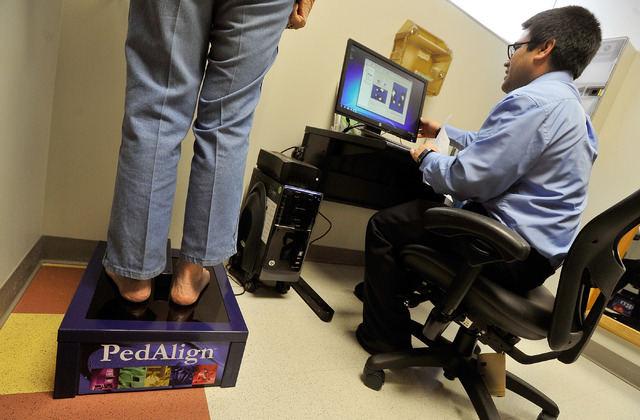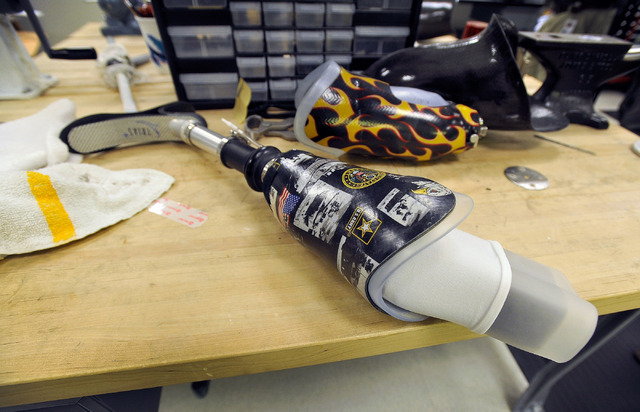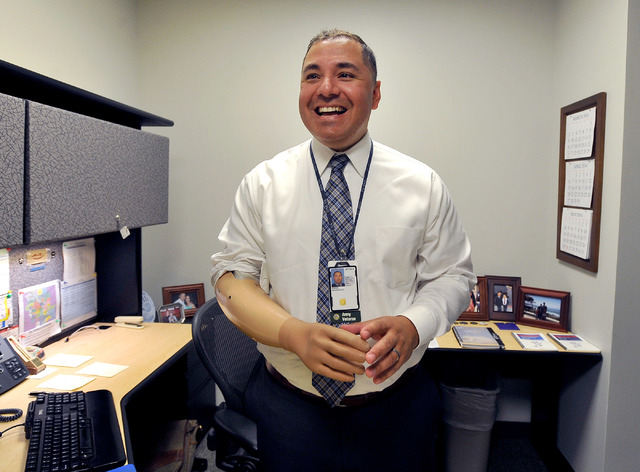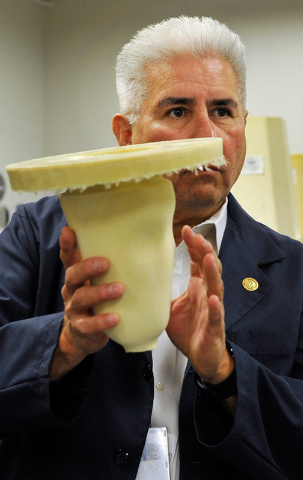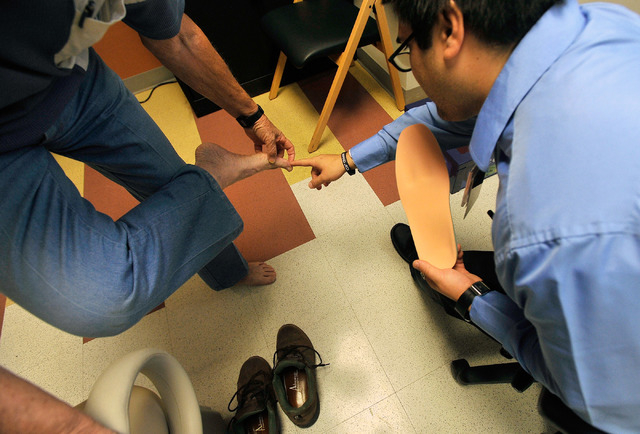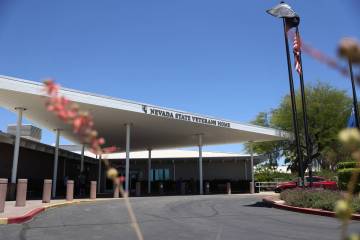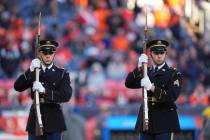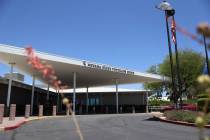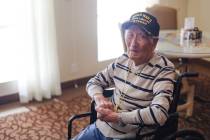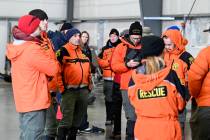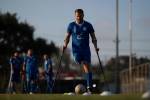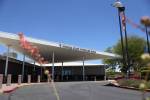Veteran amputees given a leg up at VA Medical Center in North Las Vegas
Army veteran Francisco Pinedo can snap a salute with his artificial arm.
And Marine vet Daniel Ramsey kicks butt with his prosthetic leg because he knows what it’s like to walk around with one while he makes artificial limbs for others.
That is life without flesh-and-blood limbs at the North Las Vegas VA Medical Center, where the prosthetics facility that Pinedo and Ramsey run is one of the few places in the Department of Veterans Affairs where feet, ankles, legs, hands, wrists and arms are made from scratch and fitted to perfection.
They are also equipped with electronic sensors to relay muscle-flex signals to a tiny, computer-controlled motor in a synthetic forearm, for example, so the person can grip with fake fingers or roll his wrist around.
Not only do they have all the nuts, bolts, springs, bumpers, resins, foams, lasers, cameras and special metals such as titanium and aluminum to make an amputee walk with a normal gait again — or shake a hand or hold a cup of coffee — they also have a stock of special shoes, braces, and “positive airway pressure masks,” for non-amputees to walk better, feel better and sleep soundly.
“We take it from A to Z, from the prescription room to completion, all here in house,” said Pinedo, chief of prosthetic and sensory aids service for the VA Southern Nevada Healthcare System.
“There are other facilities that have part of the processes in house and then they ‘central-fabricate’ some stuff. But this is one of the few that has the A-to-Z service and the modern technology.”
The next step for Ramsey could be taking a crack at building a character like the astronaut in the vintage-1970s television series, “The Six Million Dollar Man.”
“We can do anything in here,” he answered when asked the “six-million-Ddollar” question on a tour of the facility Tuesday.
HOW FIELD HAS EVOLVED
Ramsey, an infantry Marine who lost his leg to a landmine explosion during the Vietnam War, attended college on the GI Bill to become a prosthetist 41 years ago. He has seen technology change the field since he left active duty in 1969.
“Every 10 years I look back and I’m doing something completely different than I was 10 years ago,” he said. The art of his job was “traditional” when he started in the 1970s. “There were still a lot of wooden legs.”
The field evolved from using polyester resins to make prosthetics to acrylic and epoxy resins to make lighter legs.
He speaks with pride about his kingdom, the “full-service orthodics and prosthetics laboratory.”
“This is where we measure, fit and and design artificial limbs and custom braces. We fit them, modify them. Each one is custom made for the particular needs and specialty issues with the patient,” he said.
Legs and arms are made from an impression cast of the patient’s extremities “whether it’s an amputation or a paralyzed leg and we design a brace or an artificial limb around that,” Ramsey said.
They’ve even made a prosthetic foot with an adjustable flipper for a veteran who wanted to scuba dive.
“Just recently we had a Vietnam vet who had worn a more traditional prosthesis and we transitioned him over to a more light-weight design and he wanted to do scuba diving. He did it without a prosthesis but wanted a prosthesis to accommodate that diving activity and put a fin on it.
“So we designed an ankle so the foot went completely down so he could put a fin and then do his scuba diving. But when he was on the deck of ship, it came up and locked so he could walk on the deck,” Ramsey said. “With scuba diving activity there’s a lot of heavy stuff. He said it was really good to have that extra foot to accommodate the deck as well as his fin for scuba diving.”
Precise dimensions for a prosthetic design are produced from a laser attached to a camera that plots the leg on a computer screen. With that image, equipment and tools are programmed to carve and shape it from a foam blank.
Ramsey grabbed a typical artificial leg from his shop table and, with one hand, held its light-weight aluminum shin rod attached to a black, carbon-fiber thigh. At the bottom of the shin rod was what he called an “entry level foot,” that looks like stiff but flexible shoe sole with an ankle contraption, or “multi-articulated ankle.”
“It very closely simulates the action of a human foot,” he said, by allowing the amputee to take a normal step with ankle moving smoothly, cushioned by soft-plastic “bumper” discs.
“For example, if somebody walks on irregular terrain, like a golfer, it accommodates for that irregular terrain as the patient walks. … It allows for a very smooth gait,” he said.
A carbon-fiber “forefoot” stores energy as the person walks to rebound and propel each step. “It has a lot of really nice features for a foot,” Ramsey said.
GOOD NEWS AT THE VA
At a time of turmoil for the VA with critics levying charges of cover-ups over long waits and questionable care at VA medical centers, the one in North Las Vegas can brag about success they have in taking care of vets who lost limbs on the battlefield or later in life to diseases such as diabetes.
In shouldering that criticism during a news conference Wednesday at the White House, President Barack Obama lauded VA health professionals like Pinedo and Ramsey, saying, “There are people working in the VA who do outstanding work and put everything they’ve got into making sure that our veterans get the care, benefits and services that they need.”
The commander-in-chief said, “The most searing moments of my presidency have been going to Walter Reed, or Bethesda, or Bagram and meeting troops who have left a part of themselves on the battlefield. And their spirit and determination to recover and often serve again is an inspiration.”
That fits Pinedo whose right forearm was severed beyond repair by shrapnel from an improvised explosive device during an ambush on his Stryker vehicle in 2004 in Iraq.
Surgeons at the field hospital worked 10 hours to try to save his hand “but there was so much bone missing that they weren’t able to reattach it. So they decided to amputate,” he said.
He eventually arrived at Walter Reed Army Medical Center on Sept. 11, 2004.
“It was kind of eerie,” he said. “Once they started reducing the medication it started to sink in that I’m an amputee now. It was a lot of life changes happening all at once. I had been in combat for a year. Now I’m back in the states. My first son was born while I was deployed, so I met him for the very first time, and now I’m beginning my life as an amputee.
“It was very tough. I cried myself to sleep many nights wondering what was going on. For two weeks it was a very dark place. But everything changed when this older Vietnam veteran came to visit me who was also an amputee. He had the same amputation as I did,” Pinedo said, referring to Fred Downs, the chief consultant for prosthetics at the VA.
“He always talked about life after amputation. It totally changed my entire direction and my whole perspective,” he said. “That’s exactly what I needed to get me over the hump. Ever since then I never looked back.”
Working with fellow amputee Ramsey has given both veterans a “unique perspective,” Pinedo said.
“We’re also part of the veterans community and the amputee community here in Las Vegas,” he said. “These are people we see during off hours, we see them around town, we’re at the same veterans service organization meetings. It’s a lot more than, ‘Here’s your prosthesis. See you next time.’ We work hard to gain the trust of our local veterans. We deal with a lot of adversity sometimes but in the end we’re helping a fellow veteran. And that’s what it’s about for us.”
Contact Keith Rogers at krogers@reviewjournal.com or 702-383-0308. Find him on Twitter: @KeithRogers2.




